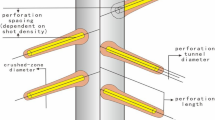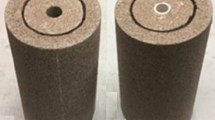Abstract
Due to engineering or geological reasons, oil and gas wells are frequently completed using a partially perforated method. Complicated spatial distribution of perforation tunnels is too difficult to be considered in the conventional analytic solution model, and there is still short of a well test model regarding the partially perforated well. Therefore, this paper develops a 3D numerical well test model for partially perforated wells, which not only accurately describe the perforation tunnels distribution near the wellbore, but also consider the characteristics of perforation compacted zone, formation damaged zone, and permeability anisotropy. The 3D finite element method is utilized to conduct numerical solutions to the model, and the pressure response curves and pressure fields are obtained for the first time. Characteristics of the pressure response curves and pressure fields are studied as well as the effects of other factors, such as perforated position, perforation compacted zone, and formation damaged zone on the pressure response curve. The results show that the pressure response of partially perforated well is characterized by both totally perforated well and partially penetrated well. It not only has an early locally radial flow characteristic around the perforation tunnels, but also has an ellipsoidal (spherical) flow characteristic. Compared with perforation at either top or bottom, the perforation in the middle weakens the inter-perforation interference. The effect of perforation compacted zone can be replaced by reducing the effective perforation radius. The increase of perforation length can largely reduce the effect of formation damaged zone on the pressure response curve and productivity of partially perforated well. Finally, the total skin computing formula of the partially perforated well is verified by means of calculation of cases with different perforation lengths and different perforated level coefficients.
Copyright 2018, Shaanxi Petroleum Society.
This paper was prepared for presentation at the 2018 International Field Exploration and Development Conference in Xi’an, China, 18–20 September, 2018.
This paper was selected for presentation by the IFEDC Committee following review of information contained in an abstract submitted by the author(s). Contents of the paper, as presented, have not been reviewed by the IFEDC Committee and are subject to correction by the author(s). The material does not necessarily reflect any position of the IFEDC Committee, its members. Papers presented at the Conference are subject to publication review by Professional Committee of Petroleum Engineering of Shaanxi Petroleum Society. Electronic reproduction, distribution, or storage of any part of this paper for commercial purposes without the written consent of Shaanxi Petroleum Society is prohibited. Permission to reproduce in print is restricted to an abstract of not more than 300 words; illustrations may not be copied. The abstract must contain conspicuous acknowledgment of IFEDC. Contact email: paper@ifedc.org.
Access this chapter
Tax calculation will be finalised at checkout
Purchases are for personal use only
Similar content being viewed by others
Abbreviations
- A j :
-
Area of grid cell surface of perforation inner boundary, m2
- A jD :
-
Dimensionless area of inner boundary discrete unit surface
- b :
-
Perforated ratio
- B :
-
Volume ratio, m3/m3
- C t :
-
Total compressibility, 1/MPa
- C :
-
Wellbore storage coefficient, m3/MPa
- C D :
-
Dimensionless wellbore storage coefficient
- h :
-
Formation thickness, m
- h D :
-
Dimensionless formation thickness
- H p :
-
Perforated thickness of formation, m
- K v :
-
Vertical permeability of initial reservoir, mD
- K h :
-
Horizontal permeability of initial reservoir, mD
- K Lh :
-
Regional horizontal permeability, mD
- K Ph :
-
Horizontal permeability of perforation compacted zone, mD
- K Fh :
-
Horizontal permeability of formation damaged zone, mD
- K vD :
-
Dimensionless vertical permeability
- K LD :
-
Dimensionless regional permeability
- K PD :
-
Dimensionless permeability of perforation compacted zone
- K FD :
-
Dimensionless permeability of formation damaged zone
- L p :
-
Perforation length, m
- L pD :
-
Dimensionless perforation length
- N :
-
Number of discrete unit surfaces of inner boundary
- p :
-
Reservoir pressure, MPa
- p i :
-
Initial reservoir pressure, MPa
- p w :
-
Bottom hole flowing pressure(BHFP), MPa
- p D :
-
Dimensionless pressure
- q :
-
Total flow rate, m3/d
- r w :
-
Wellbore radius, m
- r p :
-
Perforation radius, m
- r pD :
-
Dimensionless perforation radius
- r pd :
-
Radius of perforation compacted zone
- t :
-
Time, h
- t D :
-
Dimensionless time
- T D :
-
Dimensionless effective time
- ϕ :
-
Reservoir porosity
- μ :
-
Viscosity of fluid in reservoir, \( {\text{mPa}} \cdot {\text{s}} \)
References
Muskat M. The effect of casing perforations on well productivity[J]. Trans AIME. 1943;151:175–87.
McDowell JM, Muskat M. The effect on well productivity of formation penetration beyond perforated casing[J]. Trans AIME. 1950;189:309–12.
Harris SD. The effect of perforating on well productivity[J]. JPT, (April);1966, pp. 518–528.
Klotz JA, Kruger RF, Pye DS. Effect of perforation damage on well productivity[J]. JPT. 1974;26(Nov):1303–14.
Locke S. An advanced method for predicting the productivity ratio of a perforated well[J]. J Petrol Technol. 1981;33(12):2481–8.
Tariq SM. Evaluation of flow characteristics of perforations including nonlinear effects with the finite-element method[J]. SPE Prod Eng. 1987;2(2):104–12.
Karakas M, Tariq SM. Semianalytical productivity models for perforated completions[J]. SPE Prod Eng. 1991;6(1):73–82.
Yildiz T. Assessment of total skin factor in perforated wells[J]. SPE Reservoir Eval Eng. 2006;9(1):62–76.
Hagoort J. An analytical model for predicting the productivity of perforated wells[J]. J Petrol Sci Eng. 2007;56(4):199–218.
Atkinson C, Monmont F, Zazovsky A. Flow performance of perforated completions[J]. Transp Porous Media. 2009;80(2):305–28.
Jamiolahmady M, et al. A new method for productivity calculation of perforated wells in gas condensate reservoirs[J]. J Petrol Sci Eng. 2011;77(3–4):263–73.
Aiyin S, Yueping F, Qi L, et al. Electric analog research on perforation completion[J]. Oil Drilling Prod Technol. 1988;6:99–107 (in Chinese).
Yula T, Yingde P. Evaluation of perforating completion by finite element method[J]. Acta Pertrolei Sinica. 1989;10(3):48–58 (in Chinese).
Yildiz T, Ozkan E. Pressure-transient analysis for perforated wells[J]. SPE J. 1999;4(2):167–76.
Ozkan E, Yildiz T. Pressure-transient analysis of perforated slant and horizontal wells[R]. SPE 56421;1999.
Weiping O, Yuewu L. Effects of perforating parameters on well test type curves. Acta Petrolei Sinica. 2013;34(03):528–34.
Gringarten AC, Ramey JR, Henry J. An approximate infinite conductivity solution for a partially penetrating line-source well. SPE J. 1975;15(2):140–8.
Abbott WA, Collins T, Tippie DB. Practial application of spherical flow transient analysis. In: SPE annual fall technical conference and exhibition, Houston, Texas;1978-10-1-3.
Kuchuk FJ, Klrwan PA. New skin and wellbore storage type curves for partially penetrated wells. SPE Formation Eval. 1987;2(4):546–54.
Yildiz T, Bassiouni Z. Transient pressure analysis in partially penetrating wells. In: SPE international technical meeting, Calgary, Alberta;1990-06-10-13.
Yildiz T, Cinar Y. Inflow performance and transient pressure behavior of selectively completed vertical wells. SPE Reservoir Eval Eng. 1998;5(1):467–75.
Yildiz T. Assessment of total skin factor in perforated wells. SPE Reservoir Eval Eng. 2006;9(1):62–76.
Houqing Z. An analytical solution of gas flow towards a partially penetrated well in double porous media. Acta Petrolei Sinica. 1982;3(2):51–62.
Ciqun L. Axisymmetrical two-dimensional steady and unsteady flow through porous media. Chin J Theor Appl Mech. 1983;15(2):103–10.
Ciqun L, Deli H. A study of characteristics of the pressure build-up curves of a partially penetrated well in multiple porosity media by a method of numerical inversion of laplace transforms. Petrol Explor Dev. 1983;10(1):49–54.
Ciqun L, Jie Y. The pressure behavior in imperfect well in bottom water limestone oil reservoir. Oil Drilling Prod Technol. 1989;11(1):47–52.
Jun Y, Minglu W. Streamline numerical well testing interpretation model and pressure response for partially perforated wells. Petrol Explor Dev. 2009;36(4):513–8.
Weiping O, Yuewu L, Yizhao W. Effects of formation damage zone on bottom-hole pressure response of partially penetration-wells. Chin J Theoret Appl Mech. 2014;46(2):234–40.
Acknowledgements
Thanks to Changqing Downhole Technology Company for allowing the publication of this paper.
Author information
Authors and Affiliations
Corresponding author
Editor information
Editors and Affiliations
Rights and permissions
Copyright information
© 2020 Springer Nature Singapore Pte Ltd.
About this paper
Cite this paper
Ouyang, W., Yang, D., Sun, H. (2020). Transient Pressure Analysis in Partially Perforated Vertical Wells. In: Lin, J. (eds) Proceedings of the International Field Exploration and Development Conference 2018. IFEDC 2018. Springer Series in Geomechanics and Geoengineering. Springer, Singapore. https://doi.org/10.1007/978-981-13-7127-1_81
Download citation
DOI: https://doi.org/10.1007/978-981-13-7127-1_81
Published:
Publisher Name: Springer, Singapore
Print ISBN: 978-981-13-7126-4
Online ISBN: 978-981-13-7127-1
eBook Packages: EngineeringEngineering (R0)




